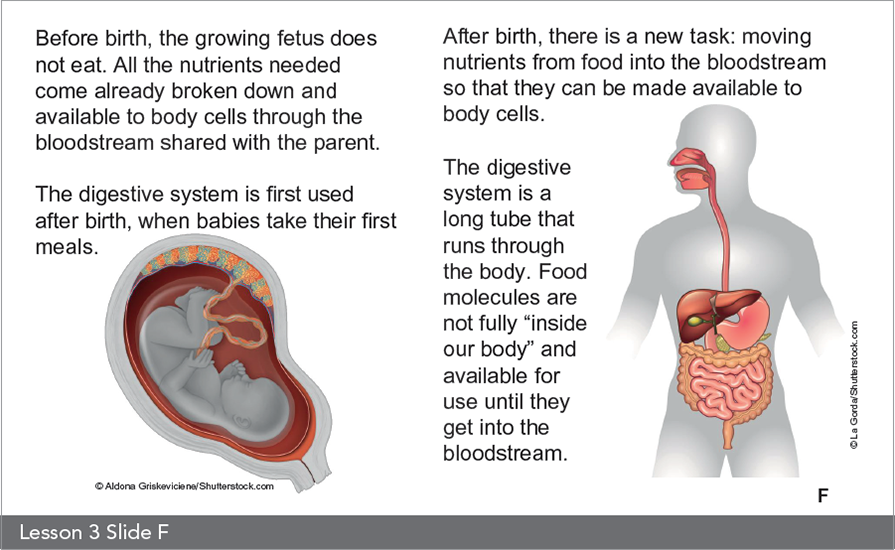CHAPTER 7
LESSON 3 How does some matter from our foods become part of our bodies?
What do we want to know?
ON YOUR OWN 
1.On a new page in your science notebook, write the date and “Lesson 3.”
2.Revisit the ideas and questions about the different molecules from food we examined in the previous lesson. Record your response in your science notebook.
a.What do we wonder about the fate of these molecules in our bodies?
TURN AND TALK 
3.Turn and talk with a partner to discuss your ideas about the following:
a.At what point does a molecule from our food become part of us? How might this happen?
WITH YOUR CLASS 
4.Participate in a class discussion about how food molecules become part of our body.
a.Help develop the lesson question.
b.Record the lesson question in your science notebook.
5.Participate in a discussion to think about a source of food for babies that we can investigate and that might help us with the lesson question.
Investigate the components in food and a baby’s growing body
ON YOUR OWN 
6.Open Student Sheet 3.3.A: How does a bottle of milk transform into a baby’s body?
a.Set a scientific purpose for reading the text.
b.Read and annotate the text.
TURN AND TALK 
7.Discuss the information in the text and the prompts with your partner.
•What new information stood out about how a single food can provide all the materials to grow a baby’s body?
•What are some of the challenges the body needs to solve?
•What new questions do you have?
WITH YOUR CLASS 
8.Participate in a class discussion, sharing what you and your partner noticed and learned from the text. Also share new questions.
Investigate how proteins in food become part of molecules in the body
WITH YOUR CLASS 
9.Consider how a baby gets nutrients before and after birth.
Absorption of nutrients. Before birth a baby does not use its digestive system. It receives nutrients through a shared circulatory system with the parent. After birth, the baby’s body must ingest, break down, and absorb molecules from food. When absorbed, the molecules move into the body’s bloodstream.

ON YOUR OWN 
10.Open Student Sheet 3.3.B: How does the body break down, absorb, and use proteins? Set a scientific purpose for reading. Then read and annotate the text.
a.After reading, share one main idea from the reading with your partner.
11.Open Student Sheet 3.3.C: How can I get all the molecules I need to make body proteins? Set a scientific purpose for reading. Then read and annotate the text.
Generate an Explanation
WITH YOUR PARTNER 
12.Obtain chart paper and some markers. Work together to develop an explanation for the prompt.
•How can a diet with a single food provide the material a baby needs to develop and grow?
CHECK
Make sure your group …
✓Includes representations of the molecules in milk as well as molecules in a baby’s body
✓Considers when food is considered to be “in the body” and when molecules are “part of the body”
✓Decides how to represent movement of molecules and changes to molecules
Investigate how carbohydrates in food are used in the body
WITH YOUR CLASS 
13.In addition to proteins, milk contains a lot of carbohydrates. Share your ideas in a class discussion about how carbohydrates might be similar or different in their digestion or absorption in the body.
ON YOUR OWN 
14.Open Student Sheet 3.3.D: Moving carbohydrates from foods into the body. Consider the scientific purpose for reading as you gather evidence from the text.
TURN AND TALK 
15.Turn and talk with a partner: What did you notice was similar and different about how carbohydrates and proteins move into, within, or through the body?
WITH YOUR CLASS 
16.Recall that lactose is a two-unit simple sugar. We will be conducting an experiment to simulate digestion of lactose in the small intestine. This will help us answer the question: How do milk sugars get absorbed into our bodies?
•Review the list of materials used in the experiment.
Materials
Markers
2 index cards
1 bottle lactase drops
5 mL of regular cow milk
5 mL of lactose-free cow milk
2 test tubes, with caps, that can hold at least 20 mL of liquid
Test tube rack
2 pipettes
4 glucose test strips (for urinalysis, not blood sugar test strips)
ON YOUR OWN 
17.Copy the chart into your science notebook and record your predictions.
Prediction: |
Observation: |
|
|---|---|---|
Regular Milk, before small intestine drops |
||
Lactose-Free Milk, before small intestine drops |
||
Regular Milk, after small intestine drops |
||
Lactose-Free Milk, after small intestine drops |
How the chart should look in your science notebook.
WITH YOUR CLASS 
18.Observe the results of testing for glucose in regular milk and lactose-free milk. Record the results in the chart in your science notebook.
19.Observe the results of testing for glucose after adding drops of small intestine fluid to the samples of milk. Record the results in your science notebook.
TURN AND TALK 
20.Share what you notice and wonder about the results with a partner.
WITH YOUR CLASS 
21.Participate in a class discussion about the simulation.
ON YOUR OWN 
22.Read Student Sheet 3.3.E: Why does drinking milk make some people sick? Use your science reading strategies to gather evidence from the text.
Update the Model Tracker
WITH YOUR CLASS 
23.We have investigated proteins and carbohydrates and figured out a lot about what happens in our bodies when these molecules are consumed. Participate in a class discussion about the lesson question.
ON YOUR OWN 
24.Return to your unit 3 Model Tracker. Complete an entry for Lesson 3.
a.What was the question we were trying to figure out in this lesson?
b.What were some of the things we figured out in connection to the lesson question?
c.If we were going to put some of these ideas in a model, how might we represent them?
SELF-ASSESS
Use the Model Tracker Self-Assessment and Feedback Tool to evaluate your model so far.
Return to thinking about the task of designing meals
WITH YOUR CLASS 
25.Participate in a discussion about eating patterns. How is it possible to sustain and grow our bodies on:
•An eating pattern with a single food source (for at least the first few months)?
•An eating pattern that includes a mixture of animal and plant-based foods?
•An eating pattern that includes mostly or entirely plants?
ON YOUR OWN 
26.Think back to the first lesson of the unit. Record your reflection and responses to the prompts.
a.Consider whether you would choose to include dairy and/or non-dairy alternatives in a meal you plan for your community. What about a meal for your family?
b.What needs or preferences would you suggest the class consider (or learn more about)?
What should we do next?
WITH YOUR CLASS 
27.Participate in a discussion about what we have figured out and what we haven’t made sense of yet. Consider both this lesson and the previous lesson. Help the class set a purpose for what we should investigate next.
